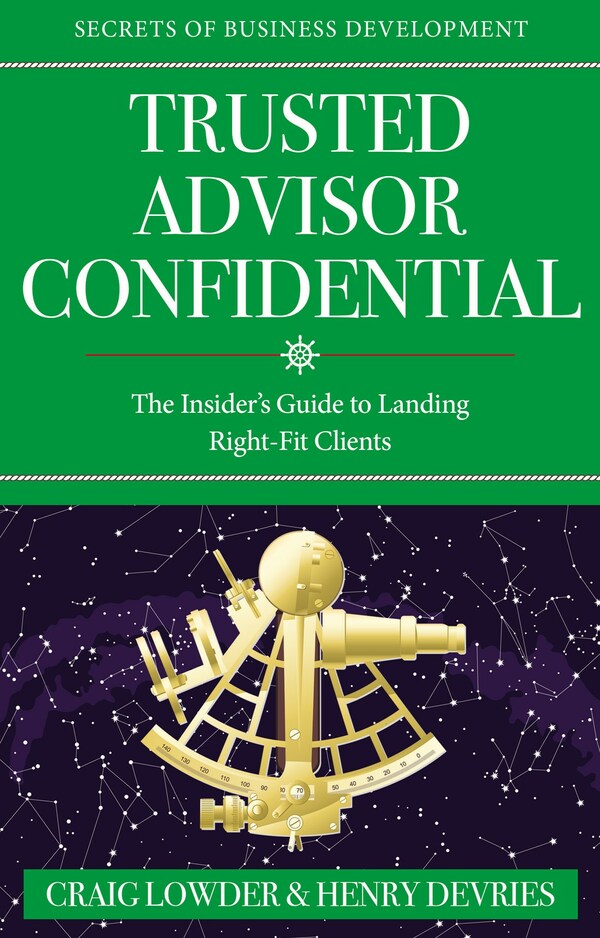Client acquisition is a science that must be artfully executed, especially by professional service professionals who want to be viewed as trusted advisors.
That is the advice of Craig Lowder, lead author of the book, Trusted Advisor Confidential: The Insider’s Guide To Landing Right-Fit Clients (2024), Indie Books International.

To research the book, Lowder and co-author Henry DeVries studied hundreds of successful trusted advisors from professional services firms including financial advisors, independent consultants, executive coaches and marketing and advertising agency owners.
“Our research shows trusted advisors can fill a pipeline with qualified clients in as little as 30 days by offering prospects advice on overcoming pressing problems,” states Lowder. “Before you can attract clients with books and speeches, you need to create a point of view that is attractive to clients. All your marketing messages will contain the elements of this point-of-view that positions you as an authority and thought leader.”
Lowder is a sales effectiveness and lead conversion expert with over 30 years of experience helping trusted advisors and small-to-midsized business owners achieve remarkable growth in their top-line revenues and personal incomes. He is a sought-after speaker and frequent contributor to professional services industry publications and is the author of Smooth Selling Forever.
DeVries is the author of 18 books on marketing, has written more than 300 business development columns for Forbes.com and other publications, is the host of the Agency Rainmaker TV show, editor-in-chief of the news website Agency Owner News, and CEO of the publishing company Indie Books International.
The authors, both MBAs, say the biggest mystery for trusted advisors is how to attract increasing numbers of right-fit clients on a regular basis. In short, seeking predictable and sustainable book-of-business growth. Here are the ten steps discussed in the book that trusted advisors can use to improve their positioning to prospective clients:
Step One. Name your business without your name. Create a business name that gives potential clients a hint at the results you can produce for them. The worst possible business name or website name is your name.
Step Two. Boil it down. Write a headline for your website and marketing materials that describe your audience and the results you produce for them. Do this in no more than ten words. The narrower the target niche, the better.
Step Three. Name your client’s pain. What are your client’s worries, frustrations, and concerns that you help solve? This is also called the FUD factor: fear, uncertainty, and doubt.
Step Four. How to fix it. Describe your solution or methodology for solving these pains. What process do you follow to produce results? Offering a proprietary problem-solving process that you name and trademark is best. This answers the all-important question in their minds: “Why should I do business with you instead of one of your competitors … or worse yet, do nothing?”
Step Five. The myths. State the common misperceptions that hold many trusted advisors back from getting results. Why doesn’t every advisor do what you do?
Step Six. Step by step. Tell your clients what they need to do in general to solve their problems.
Step Seven. The extras. List other benefits they get from following your methods and working with you as a trusted advisor.
Step Eight. Track record. Elaborate on your track record of providing measurable results for clients. Be as specific as possible. Use numbers, percentages, and time factors as proof points.
Step Nine. Give it away. Create a website and e-newsletter with free-tip articles on how to solve these pains. Each article should be between 300 and 600 words. Each tip can be numbered so it can be read easily.
Step Ten. Make an offer they can’t refuse. Offer prospects a free special report, checklist, tool, or assessment. You are offering to trade them valuable information for their email address. Tell them they will also receive a tips e-newsletter from you. Assure them you will maintain their privacy, and they can opt-out anytime.
“When potential clients tell you their problems, they expect you to tell them how you can solve them,” says Lowder. “After you outline your path to a solution, you want them to think, ‘At last: a trusted advisor who understands my problem and really knows what they are doing.'”
